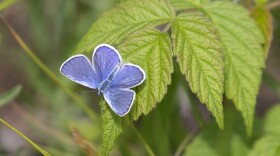A founding member of Albany's Save the Pine Bush movement will be laid to rest this weekend.
His contemporaries describe Pine Bush advocate John Wolcott as "a purveyor of justice and the truth."
Albany's Pine Bush is one of the largest of the 20 inland pine barren ecosystems in the world. Pine barrens are forests of pine trees found in otherwise "barren" agriculturally-challenging areas.
Lynne Jackson first encountered Wolcott when she was a student attending an environmental forum at the University at Albany.
"I met John Wolcott when I was 18 years old," Jackson said. "So I've known him more than 50 years. My understanding is he first visited the Pine Bush when he was 3 years old, and he was quite enamored of the beautiful Pine Bush. What happened is that Save the Pine Bush started on February 6, 1978, in the middle of a terrible snowstorm. And you know, John was one of the people who really cared about the Pine Bush and was involved from the very beginning. And John was a founder of Save the Pine Bush. And after all these years later, we realized that had there been no Save the Pine Bush, there would be no Pine Bush left today."
Executive Director of the Warren County Historical Society Don Rittner also met Wolcott at SUNY. "Much of the reason why we were successful in saving the Pine Bush is we really did a lot of research," Rittner said. "So we have the facts. And John was a very good researcher. Well, we were all good researchers, actually in those days. So it was hard to argue with facts and Mayor Corning, really appreciated that. And a lot of people don't know that Corning was not totally against preservation. In fact, in the 1960s he tried to purchase 600 acres of Pine Bush for preservation, but much of it was in Colonie and Guilderland and the two politicians around those two towns thought that Corning was trying to grab land and so it never happened. But Corning was always interested in saving some part of the Pine Bush."
Rittner went on to become Albany's City Archeologist as he continued pro-actively working with Save the Pine Bush, a long relationship that included raising awareness of the endangered Karner Blue Butterfly, whose numbers have steadily dwindled since the 1980s. He says Woloctt identified 48 Hudson Avenue as the oldest structure in the city, built in 1728 by Dutch settlers. Rittner and Jackson say Wolcott immersed himself in the history of Albany and tried to save countless old buildings from the wrecking ball.
Rittner pointed out that "Unfortunately, he did not have a good relationship with Mayor Corning and for so many years he would battle Corning over saving a lot of the historic buildings in downtown. John was trying to save lots of buildings that ended up getting torn down for sometimes no reason. Sometimes they would put an office building on top of it, something like that. So John was always going down to the Common Council chambers during public hearings, and basically reading the riot act."
Jackson added "He was instrumental in getting the hiker's underpass built. And this John had always felt that people should be able to walk, you know, east to west on the Pine Bush. The problem is how do you cross Route 155, which at some times is four lanes wide and 55 miles an hour. And he felt that we needed an underpass. And he called up the New York State Thruway when they were repairing the bridge, and suggested that they put a hiker’s underpass under the bridge, which New York State Thruway did."
In June 2001 the state Assembly passed a special resolution honoring Wolcott for his "leadership, activism and resolute devotion" to Albany.
Wolcott died Aug. 17th at age 90. Most of his personal papers documenting city history were lost in a housefire in 2021. Memorial services will be held at St. Michael's Episcopal Church in Colonie on Saturday. Wolcott be laid to rest at Graceland Cemetery in Albany.
Wolcott's legacy includes Save the Pine Bush, now 45 years old. Jackson reiterated that without Wolcott, there likely would be no Pine Bush as we know it today.
"When Save the Pine Bush started in the 1978, there were, I don't know a few 100 acres of Pine Bush ecosystem in the preserve. Now there's about 3,300 or so, 3,500 acres of Pine Bush in the preserve that are preserved and protected. But there's still about between 2,000 and 2,500 acres of Pine Bush ecosystem that are not protected. They're privately owned. And so save the Pine Bush volunteers are still out there attending public hearings, filing lawsuits, and advocating to preserve the land. There's lot of Pine Bush ecosystem that's endangered in the town of Colonie and a lot of land in the town of Guilderland. And there’s, you know, a couple thousand more acres that need to be protected," Jackson said.









